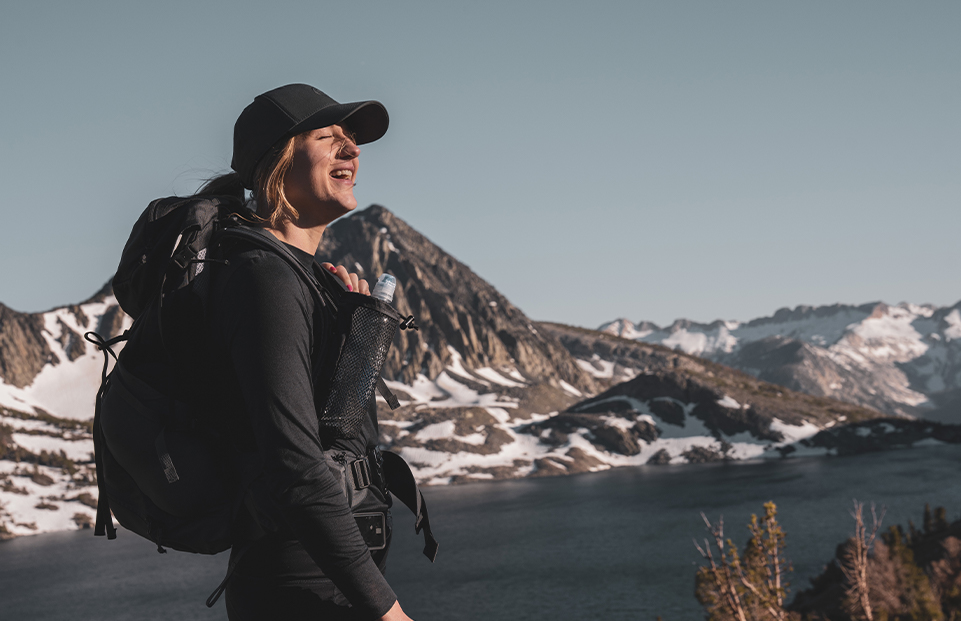Whoa, slow down there; are you seriously about to go for a hike without reading this blog first? We know that hiking is great for your health, but trust us, you’ll need more for your adventure than those boots you found sitting at the back of your garage.
So, untie your clompers, take off your hat, sit down, and take a few minutes to read about the best tips you’ll need before you hit the trails.
1. Know how long your hike is

First, as soon as you decide on which trail you’re going to be trekking, check the average time it takes to complete it. There’s nothing worse than planning for a two-hour hike, and then, suddenly, you’re five hours from your car with no water in sight.
Knowing the approximate length of your hike allows you to plan ahead and figure out what supplies you need to bring with you. The supplies needed by a beginner hiker on a day hike are going to be pretty different from what an experienced backpacker takes on a week-long journey.
Day hikes (that is, hikes where you don’t stay overnight) are a great way for beginner hikers to learn their limits, build up stamina, and get a feel for what supplies they’ll need. For longer hikes, or trails that are considered more challenging, you’ll need to make sure your day pack has all the essentials you require.
However, if you’re only going on a one- or two-hour hike, you might find that you can fit everything you need in a fanny pack. When you know how long your hike is going to be, it’s easier to plan accordingly.
2. Hydration is key

No matter how long or short your hike will be, always bring water with you. Hiking is a fantastic form of exercise, which means your body will be losing water in the form of sweat to keep you cool, and there’s nothing better than taking a refreshing swig of cold water on a hot summer day.
To ensure your water is always within reach when you need it, we recommend the CTUG water bottle sleeve. It keeps your water bottle easily accessible on your shoulder strap, so you can take a sip whenever you need it.
We found bladder systems can get grimy faster, and since it’s hard to clean, it makes adding things like electrolytes or flavor packets a chore.… CTUG’s Water Bottle Sleeve is made from XPAC, nylon mesh, and durable webbing, and it has a shock cord to keep your water bottle safe and secure throughout your journey. The mesh is helpful because you can see the water levels in your water bottle to track your water intake, and the breathability of the mesh prevents any dirt, mold, or other buildup of wetness! The universal attachment system also ensures that this Water Bottle Sleeve can fit to any backpack strap! The water bottle sleeve comes in different sizes to fit a range of different water bottles.
Safety tip: Ensuring you have enough water for your hike is essential. A good rule of thumb is to bring 1 litre of water for every two hours you’ll be hiking.
However, that can vary depending on the conditions of the hike, your own physiology and the weather. If you’re hiking in hot weather or tackling a challenging trail, you’ll need more water to stay hydrated even on shorter hikes.
3. Keep your phone handy

In this day and age, we have our phones on us at all times, but when it comes to the trails, keeping it in your pants pocket can be annoying (and it isn’t the safest place for the phone, either).
However, having your phone on you, plus an extra battery pack, is highly recommended, regardless of whether you’re hiking alone or with a group. In an emergency, the number one item you’d want to have on hand is your cell phone or other mode of communication, like a satellite phone or Garmin InReach.
Our Shoulder Strap Phone Pocket, a phone pouch for the shoulder strap of your backpacks, is the perfect piece of gear that makes it easy to travel with your phone or other mode of communication without having to worry about it not fitting in your pocket.
This phone pouch for backpacks makes it easy to reach for your phone whenever you need it, whether you need to check the map or snap a few pics of a breathtaking view.
Safety tip: While hiking beginner trails or sticking to short day hikes shouldn’t take you too far out into the wilderness, you may still want to invest in a satellite messenger, as cellular service can be unreliable on the trails.
As a rule, you should also let someone know about your hiking plans, including when you'll leave and when you'll return, for hikes of any length. That way, they can alert Search & Rescue if you don't get in touch after the hike.
4. Every Ounce Counts!

Even if you’re planning on being out in the elements for the day, it’s always good to carry some change. Using an Ultralight Wallet is a great way to reduce your weight. Swap out your bulky daily wallet, leave your punch cards and random business cards at home, and just bring what you need! Some cash, your ID and a credit card. You never know if you’re going to need to fill up on gas, buy a last-minute sandwich, or need a sweet treat!
For your hiking journey, consider either the mini, standard, or large ultralight wallet. Made from VX21 XPAC, which is a carbon-neutral and eco-friendly material, and with water-resistant seams and zippers, it’s the perfect ultralight and colorful wallet for hiking.
5. Don’t slack; get a Fanny Pack!

We know that the fanny pack fell out of fashion sometime after the 90s, but they’re making a serious comeback these days, especially with hikers. Don’t scoff; these bad boys are more versatile than you think. They free up hand space, hold your valuables, and are the perfect way to up your style game.
If you’re traveling with a furry companion, it’s a great place to store waste bags and treats, and you can even clip their leash to it. Also, if you’re going to be biking part of the trail, a lightweight fanny pack beats a heavy backpack any day of the week.
6. Plan for the weather

Last but not least, know what the weather will be like on the day of your hike. Don’t just look at the temperature; check for rain, and how strong the wind and UV index will be that day.
If the UV index shows anything over 7, you’ll want to be prepared with sunscreen, lip balm with SPF, sunglasses, and long-sleeved gear to protect your skin from sun or wind damage. If you’ll be hiking in warm temperatures, consider wearing moisture-wicking clothes to stay nice and dry. We also love wearing sunshirts, which are moisture-wicking and UV-protecting, we recommend Jolly Gear’s button-down sun shirts!
With warm weather (especially damp or humid weather), you might find yourself fighting off pests like mosquitoes. Make sure to pack bug spray and a mosquito head net.
If rain is expected, ensure you’re prepared with a rain jacket, waterproof hiking shoes and water-resistant gear. Don’t forget to bring along your seam sealed accessories, to protect your devices from the elements and keep them easily accessible at the same time.
Time to Get Hiking

Now that you’ve read this article, you’re definitely more prepared than the average person. Whether you’re just getting into hiking or have been a dedicated hiker for years, safety should always be your first priority when going on any outdoor adventure.
Be sure to bring the essentials: a first aid kit, extra water, a phone pouch for backpacks, and, of course, a smile. Remember to always do your research about the trail, double-check your gear, and, for safety reasons, always let someone know where you’re going, especially if hiking alone. Discover our top-notch Hiking Gear selection today!




1 comment
NJGB
Buy “best” first. Upgrading anything takes research, your time; money. Rather than spend on inferior items, making you hate or discard new hobbies, buy or borrow very best quality. If you can borrow, great!
Buy “best” first. Upgrading anything takes research, your time; money. Rather than spend on inferior items, making you hate or discard new hobbies, buy or borrow very best quality. If you can borrow, great!